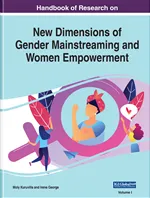Open the below link to read the chapter
https://www.igi-global.com/chapter/eazidi-womens-practices-of-empowerment-and-capital-formation-following-enslavement-by-isis/255631

Eazidi Women's Practices of Empowerment and Capital Formation Following Enslavement by ISIS
Abstract
This chapter begins by surveying the historical context of rape in Iraq through the narrative of Eazidi women who escaped enslavement by ISIS. It then discusses the theology of rape in Islam, which has motivated ISIS to commit rape and legitimized the rape of Eazidi women. The chapter then theorizes the social capital of Middle Eastern women. The chapter argues that, for the first time, the Eazidi community in Iraq is altering the social consequences of rape by developing empowerment methods that amount to a social revolution within the Eazidi community. This empowerment not only protects Eazidi women survivors from experiencing common post-rape consequences but also increases their capital, in all its Bourdieusian forms.Introduction
The struggle of women with rape in times of conflict and war dates back to antiquity. However, rape became a formal war crime in 1863 when the Lieber Instructions “classified rape as a crime of ‘troop discipline’” (Elis, 2007, p. 227). Scholarly attention to the sexual victimization of women in war and genocide began over a century later when the “first publications dealing with wartime rape as a deliberate strategy began circulation in early 1992” (Marochkin & Nelaeva, 2014, p.474). In 2015, Eazidi women who escaped sexual enslavement by the Islamic State of Iraq and Syria (ISIS) became the first women in the Middle East to publicly question rape.
The scholarly study of sexual violence in war and genocide suffers from a lack of attention, resulting in a lack of understanding rape’s political impact and the further silencing of victims (Seelinger, 2017).Studying this form of violence is made difficult due to the unwillingness of legal and political authorities to prosecute offenders and the reluctance of the military to admit their involvement in the rape crime. Yet, the rape of women during genocide and war was common throughout the 20thcentury. Atrocities were committed against women, for instance, in Europe, during World War I, Armenian genocide beginning in 1915, and the countless rapes that occurred during World War II.The heinous rape committed by Japan during World War II of “comfort women” who came primarily from Korea, China, and the Philippines was a noxious instance of sexual slavery (Argibay, 2003).
Politically, the scholarly neglect of this topic can be seen as due to the widespread failure to recognize women’s rights. Especially prior to World War I, the role of western women was mainly “restricted to the domestic sphere, as housewives, servants, and occasionally in manufacturing, clothing and textiles” (Biagini, 2015, p. 168). The circumstances of women during World War I were contradictory and multifaceted. For example, the war transformed depiction of women and created various employment opportunities for them (Campbel, 1993; Carreiras, 2006). The war also changed the governmental and political functions of women when, in 1915 at the International Women’s Congress at The Hague, the notion of peacemaking women was born (Sharp, 2013). This congress wrapped up with the idea of sending delegates from the Congress as envoys to belligerent and neutral governments and to the President of the United States to demand peace (Addams et al., 2003). While the International Congress of Women opposed the assumption that women can be protected in warfare and can eliminate the causes of war, “it protest[ed] vehemently against the odious wrongs of which women are the victims in time of war, and especially against the horrible violation of women which attends all war” (Donovan, 2012, p. 58). Although violence against women during times of war intensified following the conference, women were unable to mount a follow-up conference. Moreover, subsequent media representations of women did not aid the women’s cause.
No comments:
Post a Comment